
This eBook is for the use of anyone anywhere at no cost and with almost no restrictions whatsoever. You may copy it, give it away or re-use it under the terms of the Project Gutenberg License included with this eBook or online at www.gutenberg.org
Title: A Pictorial Booklet on Early Jamestown Commodities and Industries
Author: J. Paul Hudson
Release Date: June 25, 2012 [eBook #40080]
Language: English
Character set encoding: ISO-8859-1
***START OF THE PROJECT GUTENBERG EBOOK A PICTORIAL BOOKLET ON EARLY JAMESTOWN COMMODITIES AND INDUSTRIES***

On
Early Jamestown Commodities
And
Industries
By
J. PAUL HUDSON
Jamestown, Virginia
Illustrated by Sidney E. King
VIRGINIA 350TH ANNIVERSARY CELEBRATION CORPORATION
WILLIAMSBURG, VIRGINIA
1957
COPYRIGHT©, 1957 BY
J. PAUL HUDSON, JAMESTOWN, VIRGINIA
Jamestown 350th Anniversary
Historical Booklet Number 23
In the pages which follow only a few of many goods and commodities made, collected, or grown at or near Jamestown during the seventeenth century will be discussed. No pretense is made to do more than touch lightly on the ones mentioned most frequently by the early settlers. With the exception of tobacco, grape vines, and herbs, agricultural products are omitted.
Jamestown has never received proper recognition as the place where many American industries were born in the New World. Few people are aware that boatbuilding, timbering, glassmaking, tobacco-cultivation, wine-making, iron-smelting, and the making of pitch, tar, potash and soap-ashes, were carried on in Virginia's colonial capital; nor is it generally known that there was production of pottery, bricks and tile, of considerable volume.
Besides the products mentioned in this booklet, attempts were made to grow or produce other items at or near "James Citty"—including cordage, silk-grass, dyes, salt, flax, hemp, alum, white earth, walnut-oil, minerals, sweet-gums, madder, sugar cane, cotton, citrus fruits, olives, bark, roots, and berries. A few brought profits to the planters while others, like indigo, cotton, sugar cane, and citrus fruits, resulted in failure. The tropical plants from the West Indies could not, of course, withstand the cold Virginia winters.
Attempts made by the early planters to find commodities and raw materials revealed to a large degree the industrial and agricultural resources of the new colony. The lessons learned at Jamestown—even information derived from the failures—were invaluable ones. For from the successful activities carried out in the small huts, in the fields, and in the woodland areas, would later develop industries and agricultural pursuits undreamed of by the early settlers.
[Pg iv] The history of American commodities, like the history of the nation, is no longer a brief one. Three hundred and fifty years have now passed since the first adventurous Englishman, with musket in hand and ears alerted to the sound of moccasined feet, searched the wilderness area up and down the James River for New World wealth. As time permitted, he worked in his small shop making utilitarian things out of clay, wood, sand, and metal—objects not entirely lacking in beauty. Busy as he was with these tasks, he still found time to tend his small vineyard and tobacco field. As he worked he may have dreamed of the day when his hogs-heads of sweet-scented tobacco and casks of red wine would reach England safely and be sold for a profit. Trying to better his condition in a new land, he never dreamed that the seeds of his incessant labors, which he was unconsciously planting, would some day flower into a great industrial and agricultural nation.
INTRODUCTION
BOATBUILDING
TIMBERING
BARRELS AND CASKS
POTASH AND SOAP-ASHES
PITCH AND TAR
IRON
A JAMESTOWN BLACKSMITH SHOP
GLASSMAKING
FURS AND HIDES
BUILDING
TOBACCO
WINE
SILK
POTTERY
METALWORKING
FISHING
BREWING
HERBS AND MEDICINAL PLANTS
FURNITURE
THE BOX-MAKER AND VEHICLES
SPINNING
BREAD-BAKING
"HARVESTING" ICE
A HAPPY HOME IN JAMESTOWN
SELECTED BIBLIOGRAPHY
On April 27 1607, the day after the Jamestown colonists landed at Cape Henry, some of the settlers began to build or assemble a small boat. George Percy, one of the original colonists, reported that it was completed and launched on April 28.
It appears, therefore, that 350 years ago—on the sandy beach near Cape Henry—the Jamestown bound colonists made their first important commodity by hand in the New World.
Contemporary records reveal that many small boats were built at Jamestown from the earliest years of the settlement. They afforded the best means of transportation through the uncharted wilderness, and were used for fishing, trade, and exploration.
[Pg 2]The conjectural illustration shows colonists building a small boat at Jamestown Island—near Back River—about 1650.
 Research on painting by author.
Photo courtesy National Park Service.
Research on painting by author.
Photo courtesy National Park Service.Boatbuilding At Jamestown Over 300 Years Ago
Conjectural Painting
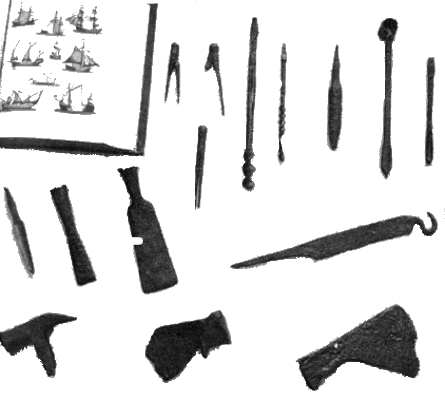 Photo courtesy National Park Service.
Photo courtesy National Park Service.All tools in the picture were hand wrought during the seventeenth century. Some may have been forged at Jamestown.
Timbering was one of the first activities undertaken by the Jamestown colonists and was one of the first English industries in America. The day the settlers arrived they began cutting down trees, for timber was needed to build their fort and town as well as to export to the mother country. Thomas Studley, a member of the first colony, reported that clapboards were made for loading on the ships which were to return to England:
Now falleth every man to worke, the Councell contrive the fort, the rest cut downe trees to make place to pitch their tents; some provide clapboard to relade the ships, some make gardens, some nets, &c.
Captain Newport left Jamestown in June, 1607 and aboard his two ships were clapboards and other wooden products.
The virgin forests growing in the vicinity of Jamestown furnished planks, masts, clapboard, wainscoting, and other wooden products needed by the mother country. As England had run short of timber and was paying exorbitant prices to European countries for naval stores and timber products, the supply furnished by the Jamestown colony helped greatly to relieve the situation. The Virginians were also helped, for timber was one of the few products which brought profits to the struggling colony.
The conjectural painting shows settlers carrying out timbering activities at Jamestown. Some of the piled up lumber will be used in the colony, some will be shipped to England.
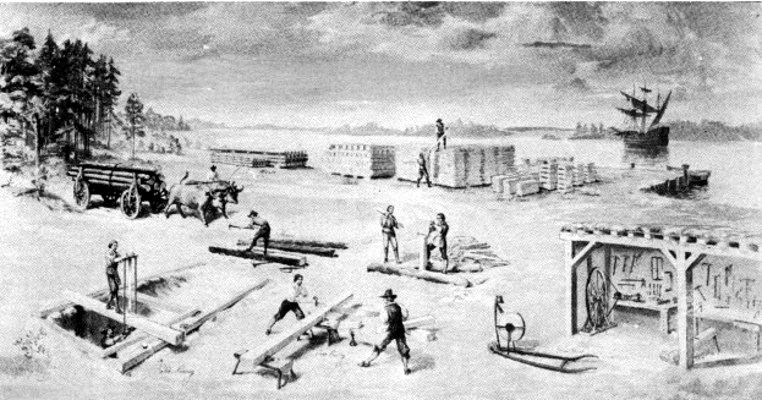 Research on painting by author. Photo courtesy National
Park Service.
Research on painting by author. Photo courtesy National
Park Service.Timbering At Jamestown Three Centuries Ago
Conjectural Painting
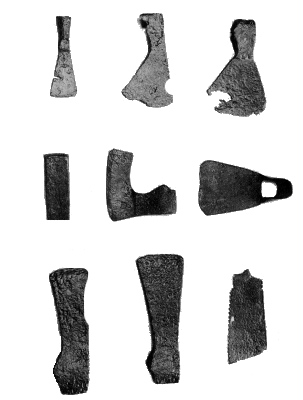 Photo courtesy National Park Service.
Photo courtesy National Park Service.Tools Used By The Early Jamestown Settlers For Timbering
A few of many tools excavated at Jamestown which were used for timbering over 300 years ago: felling axes, a hewing axe, adze, hatchet, wedge, and saw fragment.

The Carpenter. Faber Lignarius.
We have seen Mens food and cloathing; now his dwelling followeth. At first they dwelt in Caves 1 then in Booths or Huts 2 and then again in Tents 3 at the last in Houses. The Woodmen felleth and heweth down Trees 5 with an Ax 4 the Boughs 6 remaining. He cleaveth Knotty wood with a Wedg 7 which he forceth in with a Beetle 8 and maketh Wood-stacks 9. The Carpenter squareth Timber with a Chip-Ax 10 whence Chips 11 fall, and saweth it with a Saw 12 where the Saw-dust 13 falleth down. Afterwards he lifteth the beam upon tressels 14 by the help of a Pulley 15 fasteneth it with Cramp-Irons 16 and marketh it out with a Line 17. Then he frameth the Walls together and fasteneth the great pieces with Pins 19.
Courtesy Folger Shakespeare Library, Washington, D. C.
Seventeenth Century Timbering and Building
The 1685 engraving shows activities relating to timbering and house building. Similar practices were carried out at Jamestown during the seventeenth century. From Orbis Sensualium Pictus by Johann Comenius (London, 1685).
(COOPERING)
As early as 1607 barrel staves were made at Jamestown for exporting to England. Later, when tobacco and other crops were grown successfully—and a few commodities were produced in Virginia for export—barrels, casks, and other wooden containers were made by the cooper in large numbers.
John Lewes was the first cooper to reach Jamestown, arriving in January, 1608. Others followed him throughout the seventeenth century; and for almost a hundred years their craft was an important one in the "Capital Cittie."
The illustration shows a cooper and his helpers making barrels and casks at Jamestown, about the year 1625.
 Research on painting by author. Photo courtesy National
Park Service.
Research on painting by author. Photo courtesy National
Park Service.
Making Barrels and Casks At Jamestown—About 1625
Conjectural Painting
 The Cooper.
The Cooper.The Cooper 1, having an Apron 2 tied about him, maketh Hoops Of Haslel-rods 3, upon a Cutting-block, 4 with a Spoke-shave, 5 and Lags 6 of Timber. He maketh Hogs-heads 7 and Pipes, 8 with two Heads, and Tubs 9, Soes 10, Flaskets 11, Buckets 12, with one Bottom of Lags. Then he bindeth them with Hoops 13, which he tieth fast with small Twigs 15, by means of a Cramp-Iron 14, and he fitteth them on with a Mallet 16, and a Driver. 17.
Courtesy Folger Shakespeare Library, Washington, D. C.
Making Barrels in the Seventeenth Century
The engraving, made in 1685, shows two coopers making a barrel. A cooper's shop at Jamestown may have been somewhat similar to the one shown.
From Orbis Sensualium Pictus by Johann Comenius (London, 1685).
Soap-ashes and potash were among the first commodities produced by the English in America. Potash was made from soap-ashes (wood ashes, especially those obtained from burning ash and elm) and was used at Jamestown for making both soap and glass. Soap-ashes were exported to England as early as 1608, and throughout the remainder of the century it appears that both potash and soap-ashes were shipped to the mother country, As early as 1621 soap-ashes were selling for six shillings to eight shillings per hundred weight, whereas potash was bringing between thirty-five shillings and forty shillings per hundred weight.
Although few contemporary records are available which mention the profit made from the sale of soap-ashes and potash by the Virginia planters, it is known that some small returns were made from time to time throughout the seventeenth century. While tobacco was the important money-making crop, the part played in the economy of the Jamestown settlement and environs by other commodities—including soap-ashes and potash—should not be overlooked.
In the conjectural picture Jamestown settlers are shown making potash. Five steps were necessary:
1. A pile of firewood (billet-wood) was burned until grey ashes
were formed. The best woods were oak, ash, poplar, hickory, elm,
hazel, and beech. Old hollow trees, if not dead, were especially
desirable.
2. After several pounds of ashes had accumulated, they were leached
(boiling water was percolated through the ashes), resulting in a
very strong alkali solution known as ley or lye.
3. The alkali solution (or ley) was strained through a coarse linen
cloth to keep out any coarse materials (such as small pieces of
half-burnt wood), that might happen to remain in the ashes.
4. The strained ley solution was poured in an iron pan, and
evaporated over a quick fire—almost to dryness.
5. The residue remaining in the bottom of the pan was removed and put
into an iron pot. The pot was put over a strong fire till the matter was
melted. Immediately the melted matter was poured out upon an iron plate,
where it soon cooled and appeared in the form of a solid lump of
potash.
[Pg 12]
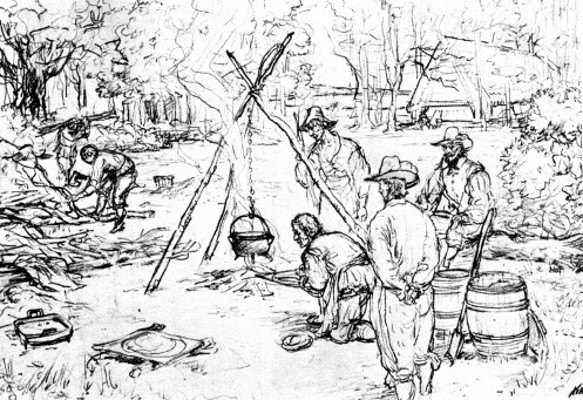 Making Potash at Jamestown—About 1608
Conjectural sketch
Making Potash at Jamestown—About 1608
Conjectural sketchTo a chemist the somewhat primitive methods described are very obvious ones in making an impure form of potash. The combustion of hardwoods resulted in an ash residue containing the desired potassium carbonate. Some purification was obtained by leaching the ash residue in boiling water and then filtering the "ley" through a coarse linen cloth. The filtered "ley" was evaporated in an iron pot to dryness. The potash resulting was now ready for making soap and glass, as well as for other industrial uses.[Pg 14]
Pitch and tar—used by shipbuilders from time immemorial for caulking and covering seams of vessels—were made at Jamestown as early as 1608. After the second supply ships reached Jamestown in October, 1608, one of the settlers wrote:
No sooner were we landed, but the President dispersed [as] many as were able, some for glasse, others for pitch, tarre, and sope ashes.
A month later trials of pitch and tar were carried to England by Captain Christopher Newport, as reported by Thomas Studley, one of the original planters:
Captaine Newport being dispatched with the tryals of pitch, tarre, glass, frankincense and sope ashes, with that clapbord and wainscot [which] could bee provided ... returned for England.
As pitch and tar were made in Virginia throughout the seventeenth century, mainly for exporting to England, it appears that the colonists made some profit from the sale of such products.
Pitch and tar were obtained from pine trees, one of the common trees in the Tidewater Virginia woods. Tar is an oily, dark colored, product obtained in the destructive distillation of pine wood. In Virginia it was commonly made from the resinous roots and wood of various pines. The wood was heaped into a conical stack depressed at the center, covered with earth, and fired. The tar ran into a hollowed-out place in the soil beneath the stack of wood. Pitch was a dark-colored viscous substance obtained as a residue in distilling pine tar, and widely used for caulking seams of boats.
It is of interest that the early settlers named the large swamp north of the town area "Pitch and Tar Swamp." Undoubtedly the large pine trees which bordered the swamp were used for making pitch and tar, as well as turpentine and resin.
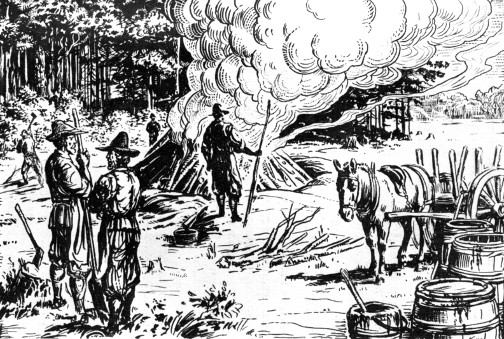 Making Tar At Jamestown From Pine Wood
Making Tar At Jamestown From Pine Wood
Conjectural sketch
It is possible that small amounts of iron were smelted at Jamestown in earth ovens or Catalan-type furnaces during the early years of the colony. In 1955 archeologists unearthed a circular-shaped pit which contained charcoal, burned oyster shell, iron ore, pieces of smelted iron, and slag. It is known that some iron was made in earth ovens in England during the early years of the seventeenth century, where iron was smelted in holes dug in the ground. The fires were fed with logs and charcoal, and the heat was increased by use of large foot bellows. The same method may have been used at Jamestown; or it is possible that the "earth oven" may have been used for hardening bar iron imported from England, as much bar iron received from the mother country was very soft and unsatisfactory for making tools.
The conjectural sketch shows Jamestown colonists making iron in a primitive earth oven or furnace.
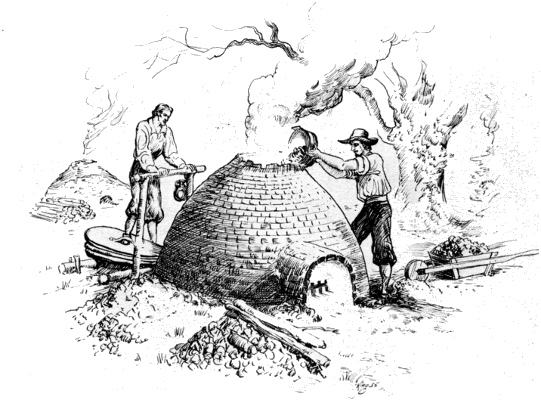 Small Quantities Of Iron May Have Been Made At Jamestown
During The Early Years Of The Settlement.
Small Quantities Of Iron May Have Been Made At Jamestown
During The Early Years Of The Settlement.
Conjectural sketch
A blacksmith, James Read by name, was a member of the first group of colonists who planted the Jamestown settlement in 1607. Perhaps he helped forge the small chisels which Captain John Smith mentioned (writing of the month of September, 1607):
As yet we have no houses to cover us, our tents were rotten, and our cabbins worse than nought: our best commoditie was iron which we made into little chissels.
Many small chisels have been unearthed at Jamestown, and one may wonder whether any were made during the hard autumn of 1607, when the state of the new colony was at such a low ebb.
Another early Jamestown blacksmith was Richard Dole, who arrived on the supply ship Phoenix, April 20 1608. Read and Dole were the vanguards of many ironworkers who emigrated to Virginia at various periods of time throughout the seventeenth century.
In 1955 archeologists discovered the site of an early seventeenth century forge or smithery near historic Jamestown church. Large quantities of slag were unearthed together with pieces of bar iron, weapons, tool fragments, and several partially-completed iron handles, chisels, and nails. A few blacksmiths' tools and a small anvil were also found. Associated cultural material found indicated that the forge operated between 1610 and 1625, and there was good evidence that it may have been located in an armourer's shop. The forge site appears to be the oldest one used by the English which has been discovered in America.
The sketch showing the Jamestown blacksmith at work is based on a 1685 engraving by Johann Comenius.
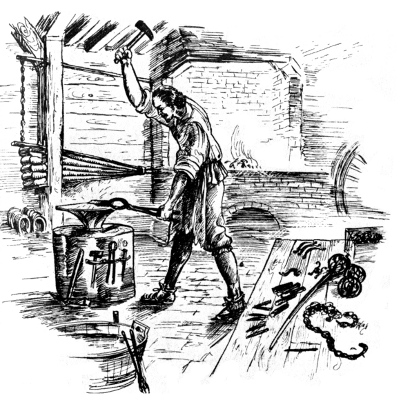 A Jamestown Blacksmith Working In A Forge Shop
A Jamestown Blacksmith Working In A Forge Shop
Conjectural sketch
 Photo courtesy National Park Service.
Photo courtesy National Park Service.Iron Objects Excavated At Jamestown Near The Site Of An Early
Seventeenth-Century Forge.
Shown are blacksmiths' tools, bar iron, sword guards, slag, and a few
incomplete iron objects. It appears that the forge, located a short
distance west of historic Jamestown church, was in operation as early as
1625.
 The Indian Massacre At Falling Creek, March 22 1622
The Indian Massacre At Falling Creek, March 22 1622
Conjectural sketch
In 1620-21 the Jamestown colonists established an iron furnace at
Falling Creek—about eighty miles upriver from Jamestown. It was
the first ironworks built in America by Englishmen, and the furnace was
the first one (of which there is definite record) in which iron was
smelted. The contemporary records also indicate that a few tools were
made in the forge shop. The enterprise was short-lived, however, for in
1622 the Indians massacred the ironworkers and their families and
destroyed the furnace. Although never rebuilt, its importance cannot be
overstressed, for the Falling Creek site can rightfully claim the honor
of being the birthplace of the American iron industry.[Pg 22]
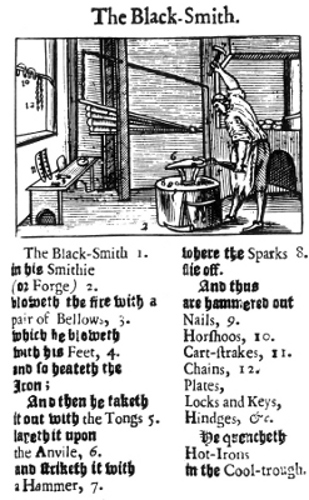 The Black-Smith.
The Black-Smith.The Black-Smith 1 in his Smithie (or Forge) 2 bloweth the fire with a pair of Bellows, 3 which he bloweth with his Feet, 4 and so heateth the Iron; And then he taketh it out with the Tongs 5 layeth it upon the Anvile, 6 and striketh it with a Hammer, 7 where the Sparks 8 flie off. And thus are hammered out Nails 9, Horshoos 10, Cart-strakes 11, Chains 12, Plates, Locks and Keys, Hindges, &c. He quencheth Hot-Irons in the Cool-trough.
Courtesy Folger Shakespeare Library, Washington, D. C.
A Seventeenth-Century Blacksmith At Work
A forge or smithery at Jamestown may have resembled the one in this 1685 engraving.
From Orbis Sensualium Pictus by Johann Comenius (London, 1685).
Glass was made at Jamestown in 1608-1609, and again in 1621-1624, its manufacture being one of the first English industries in the New World.
Among the colonists who reached Jamestown in October, 1608, were "eight Dutchmen and Poles," some of whom were glassmakers. When Captain Christopher Newport sailed for England a few weeks later he carried with him "tryals of pitch, tarre, glasse, frankincense, sope ashes; with that clapboard and waynscot that could be provided." It is not known what kinds of glass were taken to England by Newport. John Smith, writing of the year 1609, stated: "... wee made three or foure lotts of tarre, pitch, and sope ashes; produced a tryall of glass...." Again, the records do not reveal what kinds of glass were produced.
In 1621 six Italian glassmakers arrived at Jamestown, and during the next three years attempts were made to manufacture glass, but it appears that only small amounts were blown.
Oddly enough, archeological excavations did not disclose what kinds of glass were made at Jamestown during the two ventures. When the glasshouse site was excavated in 1948 only small fragments and drippings—dark green in color—were found. It appears that the tiny fragments could have been pieces from window panes, bottles and vials, and simple drinking glasses. No glass beads were found at or near the furnace site.[Pg 24]
The conjectural sketch shows a Jamestown glassblower at work.
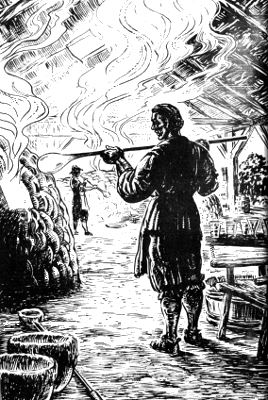 Making Glass At Jamestown In 1608
Making Glass At Jamestown In 1608
Conjectural sketch
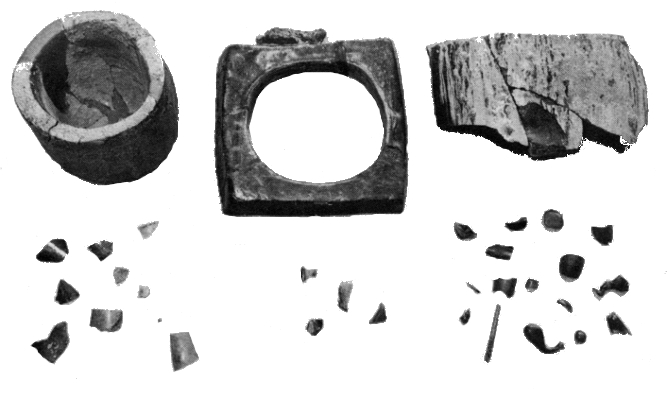 Photo courtesy National Park Service.
Photo courtesy National Park Service.
Artifacts Relating To Glassmaking—Found Near The Site Of The Jamestown Glasshouse.
In the picture are shown a small melting pot, part of a working hole, fragment from a large melting pot, cullet (the broken or refuse glass in the lower left corner), and green glass fragments (lower center and lower right)[Pg 26]
Shortly after the Jamestown colony was planted the English adventurers explored the rivers and bays in the vicinity of the settlement, visited many Indian villages, and traded colorful articles to the natives in exchange for foods, furs, and other commodities.
The first exploring party left Jamestown a week after the establishment of the colony. Twenty-four of the settlers sailed up the James River as far as the falls, a distance of about ninety miles. At Arahatteak (near present-day Richmond) the explorers gave the Indians "penny knyves, sheeres, belles, beades, glass toyes &c ..." for mulberries, wheat, beans, tobacco, and a "crowne which was of deares hayre, dyed redd." Before leaving the village Captain Newport presented the Indian chief with a hatchet and a red waistcoat.
On the return trip to Jamestown the exploring party visited other Indian towns on the James River, including one whose chieftain was Powhatan's brother—the wily and crafty Opechancanough. Gabriel Archer, a member of the group, recorded that the chief's "kyngdome is full of deare (so also is most of all the kyngdomes:) he hath (as the rest likewise) many ryche furres."
Many of the early settlers listed the fur-bearing animals that inhabited the dense woods near Jamestown. George Percy, an original planter, observed that:
There is also great store of deere both red and fallow. There are beares, foxes, otters, bevers, muskats, and wild beasts unknowne.
John Smith, in one of his early books describing Virginia (A Map of Virginia, With a Description of the Country, Oxford, 1612), gives brief descriptions of deer, squirrels, opossums, muskrats, bears, beavers, otters, foxes, and others. With the exception [Pg 27] of bears, these fur-bearing animals still inhabit Jamestown Island—protected by the National Park Service.
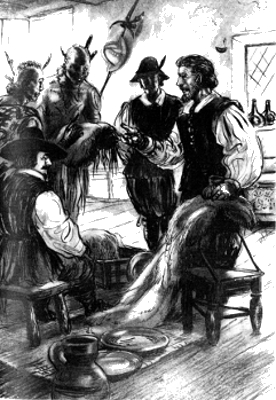 Jamestown Settlers Trading With The Indians
Jamestown Settlers Trading With The IndiansConjectural sketch
For inexpensive beads and trinkets the colonists received furs, foods, and other commodities from the aborigines.
It appears that early in the century some profit was being made from the sale of furs in England, for Thomas Studley, who was in charge of the first storehouse at Jamestown, wrote that "one mariner in one voyage hath got so many [furs] as he confessed to have solde in England for £30."
William Strachey, who lived at Jamestown in 1610-1611, described a trading expedition made by Captain Samuel Argall in 1610:
Within this river, Captayne Samuell Argoll in a smale river which the Indians call Oquiho. Anno 1610. trading (in a bark called the Discovery) for corne, with the great king of Patawomeck, from him obteyned well neere 400. bushells of wheat, pease and beanes (besyde many kind of furrs) for 9. powndes of copper, 4. bunches of beades, 8 dozen of hatchetts, 5 dozen of knives, 4 bunches of bells, 1. dozen Sizers, all not much more worth than 40s. English....
It is evident, therefore, that the Jamestown colonists who traded their colorful beads and trinkets to the woodland Indians in exchange for food and other commodities—including furs and hides—were the pioneer English fur traders in the New World. The experiences which adventurers like Christopher Newport, John Smith, and Samuel Argall had with the cunning Virginia aborigines were just as exciting and stirring as those shared by the hardened trappers and traders who searched the Rocky Mountain streams for beaver two hundred years later. The hunt for furs which began at Jamestown in 1607 did not diminish until the western boundary of the United States had expanded to the shores of the Pacific Ocean during the middle of the nineteenth century.
 Photo courtesy National Park Service.
Photo courtesy National Park Service.Objects Found At Jamestown Which Were Used For Trading With The Indians Shown are glass beads, bell fragments, a hatchet, scissors, knives, and an incomplete brass pan.[Pg 30]
The day the colonists landed at Jamestown, May 14 1607, they began building a triangular-shaped fort ("a pallizado of planckes and strong posts, foure foote deepe in the ground, of yong oakes, walnuts, &c."), "a setled streete of houses," a church, a guardhouse, and a storehouse. It is apparent that all men familiar with tools and building skills were extremely busy during the first few weeks, especially the four carpenters in the group (William Laxon, Edward Pising, Thomas Emry, and Robert Small), two bricklayers (John Herd and William Garret), and mason (Edward Brinto). As brick houses were not built at Jamestown until about 1625, the bricklayers who came to Virginia with the first group of colonists undoubtedly aided the carpenters. Perhaps it was they who made the first stone footings and mud and stick chimneys for the frame houses which were built inside the fort.
As timber was plentiful in Virginia during the early years of the settlement, most of the houses were of frame construction. During the first decade or two house construction reflected a primitive use, not of materials brought from England but those that were found ready at hand, such as saplings for a sort of framing, use of branches, leafage, bark and animal skins. During these early years, when the settlers were having a difficult time staying alive, mud walls, wattle and daub, and marsh grass thatch of a coarse sort were used. Out of these years of improvising the construction with squared posts, later with quarterings (studs), came into practice. There probably was little thought of plastering walls during the first two decades, and when it was done, clay, or clay mixed with oyster shell lime, was first used. The early floors were of clay, and it should be remembered that clay floors continued to be used in the humbler dwellings throughout the seventeenth century. It can be assumed that most of the dwellings, or shelters, of [Pg 31] the Jamestown settlers, certainly until about 1630, had the primitive appearance of "settlers" houses, and were rough on the exterior.
 The Landing
May 14 1607.
The Landing
May 14 1607.Conjectural sketch
From A Pictorial Story of Jamestown Virginia: The Voyage and Search for a Settlement Site, by J. Paul Hudson. Not to be reproduced without permission of the author.
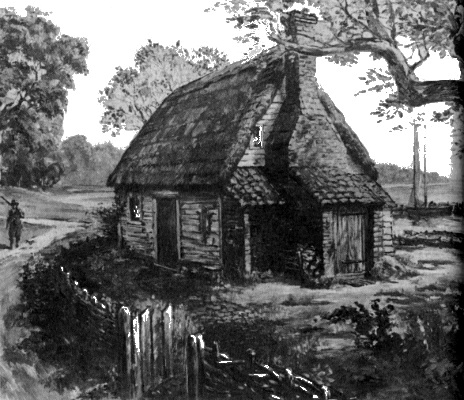 Photo courtesy National Park Service. Research by A.
Lawrence Kocher.
Photo courtesy National Park Service. Research by A.
Lawrence Kocher.
A Small Jamestown House Built About 1630
Conjectural Painting
The frame house shown is believed to be typical of many built by the yeomen settlers after 1630. A coarse marsh grass thatch covers the roof and rough clapboards cover the sides of the building. The few casement windows used have diamond-shaped panes, and heavy wooden doors swing on hand wrought iron strap hinges. In the foreground is a large brick chimney, oven, and woodshed. The shed and recessed nook in front of the oven are covered with red earthenware pantiles. Jamestown has taken on a degree of permanency, and many of the Colonists are realizing small profits from the sale of tobacco.
After the settlement had become fairly well established the colonists began building a few brick houses. In the picture English artisans are shown erecting a small brick structure at Jamestown about the year 1630. It is quite clear from the documentary records and the archeological remains that the colonists not only made their own bricks—and probably many of their roofing tiles—but that the process, as well as the finished product, followed closely the English tradition.
An old account, relating to brick-making in England three hundred years ago, is summarized:
1. Before Christmas we begin to dig the earth and let it lie to mellow till Easter.
2. Then we water the earth well and temper it with a narrow spade.
3. The moulder cuts off a piece of earth, throws it into the mould made of beech, levelling it off with a wooden implement called a strike.
4. The carrier carries the mould to the drying ground, where he adroitly turns it over, laying the bricks on the ground, and lifts up the mould.
5. When the bricks are dry, they carry them to a place where they row them up like a wall. They are covered with straw, till they are dry enough to be carried to the kiln.
6. Then they are stacked in the kiln, a fire kept till they are at the top red fire hot.
7. Then we let them cool, and sell them as we can for as much money as we can get, but usually about 13 or 14 shillings the thousand.
Similar methods may have been used at Jamestown during the seventeenth century.
 Building A Small Brick House At Jamestown, About 1630
Building A Small Brick House At Jamestown, About 1630
Conjectural sketch
 Making Brick At Jamestown About 1650
Making Brick At Jamestown About 1650
Conjectural sketch
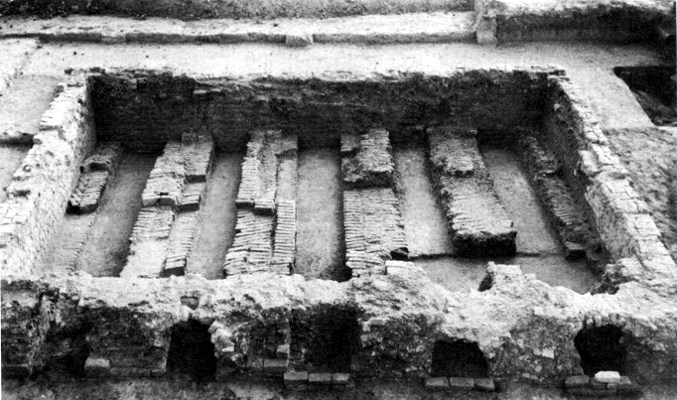 Photo courtesy National Park Service.
Photo courtesy National Park Service.
Overall View Of Brick Kiln Unearthed at Jamestown
In addition to bricks, flat roofing tiles were found in this kiln—placed there for firing with the bricks. Four brick kilns were discovered at Jamestown during archeological explorations.In order to build brick houses lime was needed by the bricklayers and plasterers for making plaster and mortar. Contemporary records reveal that "lymeburners" emigrated to Jamestown as early as 1610. As four lime kilns were found during archeological excavations, it is evident that the lime used by the Jamestown builders was made on the historic island. In the kilns oyster shells from the James River were burned and converted into lime by the limeburners.
The unearthing of large quantities of plaster and mortar at Jamestown indicates that the majority of the brick houses (as well as many frame structures) had plastered walls and ceilings, especially after 1635. Some plaster excavated had been white-washed while other bore its natural whitish-gray color. All plaster and mortar found was made from oyster shell lime, sand, and clay.
Ornamental or decorative plaster was found near a few of the house foundations. The plasterwork, decorated in raised ornamental designs, was used for enhancing the beauty of both the interior and exterior of a building. Designs on the plaster included Roman numerals, letters, mottos, crests, veined leaves, rosettes, geometric patterns, a lion, and a face or mask. Many fragments of moulded plaster cornices were also recovered. Broken oyster shells are distinguishable in the ornamental plasterwork, indicating that the pargetting was made at Jamestown.
 Making Lime From Oyster Shells, About 1625
Making Lime From Oyster Shells, About 1625
Conjectural sketch
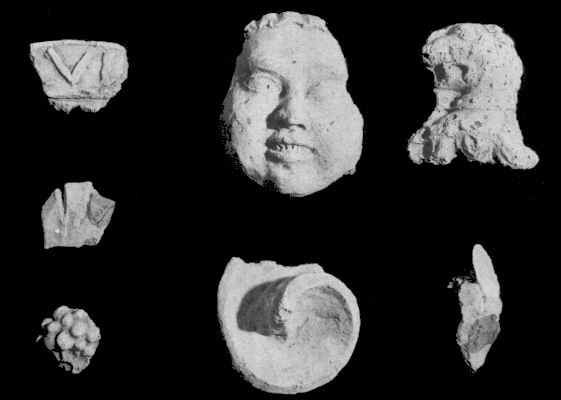 Photo courtesy National Park Service.
Photo courtesy National Park Service.
Ornamental Plaster Made At Jamestown
Archeological explorations revealed that ornamental plaster was used on a few Jamestown buildings—for enhancing the beauty of both the exterior and interior. Broken oyster shells are imbedded in the decorated plaster, indicating that the pargetting was made at Jamestown.When Jamestown was established in 1607 the Indians living in Tidewater Virginia were smoking a leaf from the native tobacco plant, Nicotiana rustica. It was a bitter tasting leaf of rather poor quality, and never cultivated on a large scale by the early planters.
About 1611, seeds of a West Indies tobacco plant, Nicotiana tabacum, were introduced into Virginia. A year later John Rolfe experimented with the seeds from the West Indies plant, together with tobacco seeds from South America. The exact nature of Rolfe's tests, carried on at or near Jamestown, is unknown, but the plant he seemingly developed was one with a mild, sweet-scented, leaf.
The new sweet-scented leaf became popular overnight, and during the remainder of the seventeenth century it proved the economic salvation of the colony. To a large degree, the new crop determined the economic, social, and political life of the planters. The demand in England for the new leaf was also responsible, in a large measure, for the spread of settlement and increase of population in Virginia. The tobacco plant developed by Rolfe was the first crop grown by the Virginia settlers which made a profit.
The conjectural illustration shows Jamestown colonists harvesting tobacco about the year 1650.
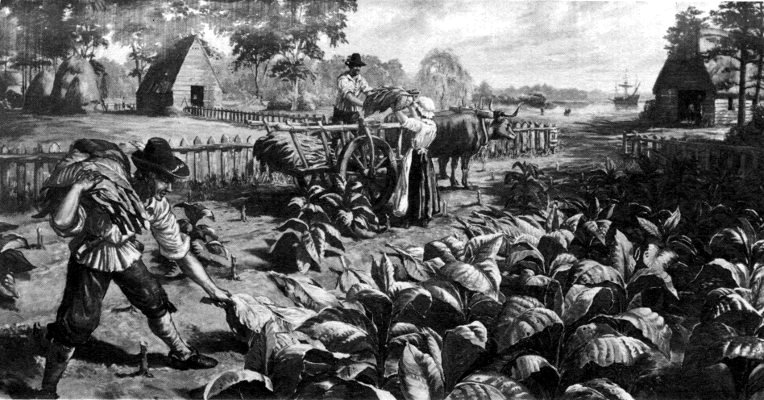 Research on painting by author. Photo courtesy National
Park Service.
Research on painting by author. Photo courtesy National
Park Service.
Harvesting Tobacco At Jamestown About 1650
Conjectural Painting
During the early years of the Jamestown settlement the Virginia Company of London encouraged many agricultural pursuits, including the planting and cultivation of grape vines and the making of wine. The reasons seemed to have been twofold: first, to make money for the Virginia Company, whose stock-holders had invested much capital in the new colony; and secondly, to insure the mother country a steady flow of inexpensive wine—which was impossible as long as continental merchants charged exorbitant prices for wines sent to England. Then, too, if wine could be made successfully in Virginia, the people living in the new settlement would profit accordingly.
Vineyards were planted on Jamestown Island at various periods of time during the seventeenth century, and quantities of good wines were made, but far too often inferior wine was fermented. Because of the long sea journey from Virginia, casks of good wine sent to England frequently arrived in a spoiled condition.
After 1675 the hope of producing good Virginia wine for export purposes waned. During the last ten years of the century, when Jamestown declined, the vineyards were neglected, fell prey to deer and the elements, and soon became engulfed in the wilderness.
The illustration shows a man and woman pressing grapes at Jamestown about 1650. The woman is trampling them, whereas the man is using a primitive grape press.
 Research on painting by author. Photo courtesy National
Park Service.
Research on painting by author. Photo courtesy National
Park Service.
Making Wine At Jamestown About 1650
Conjectural Painting
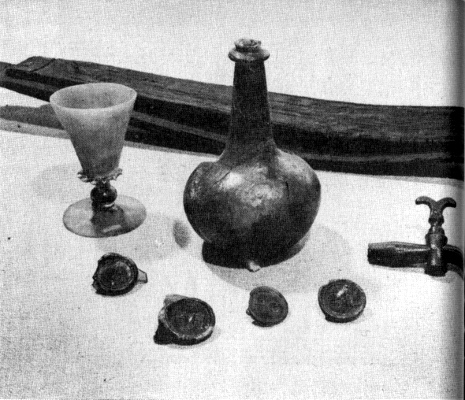 Photo courtesy National Park Service.
Photo courtesy National Park Service.
Items Found At Jamestown Relating To Wine
Wine was a popular beverage in Virginia during the seventeenth century. A few items unearthed at Jamestown which relate to wine consumption are shown: a wine bottle, wine glass, glass bottle seals (which were attached to the shoulders of many wine bottles), a bronze spigot, and wooden barrel staves. In 1610 Francisco Maguel, who had spent eight months in Virginia, wrote that "There grow in that country [Virginia] wild many forest grapes, of which the English make a wine that resembles much the wine of Alicante, according to the opinion of the narrator who has tasted both." [Pg 45]
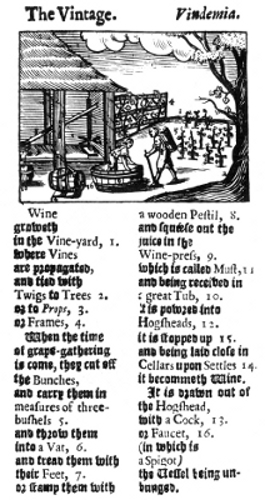 The Vintage. Vindemia.
The Vintage. Vindemia.Wine groweth in the Vine-yard 1, where Vines are propagated, and tied with Twigs to Trees 2, or to Props 3, or Frames 4. When the time of grape-gathering is come, they cut off the Bunches, and carry them in measures of three bushels 5, and throw them into a Vat 6, and tread them with their Feet 7, or tramp them with a wooden Pestil 8, and squèese out the juice in the Wine-press 9, which is called Must 11, and being received in a great Tub 10, it is powred into Hogs-heads 12, it is stopped up 15 and being laid close in Cellars upon Settles 14 it becommeth Wine. It is drawn out of the Hogshead, with a Cock 13, or Faucet 16, (in which is a Spigot) the Vessel being unbunged.
Courtesy Folger Shakespeare Library Washington, D. C.
Making Wine In 1685
Courtesy Folger Shakespeare Library, Washington, D. C.
The interesting engraving entitled "The Vintage" was made in 1685. A wine making establishment at Jamestown may have resembled the one in the illustration.
From Orbis Sensualium Pictus by Johann Comenius (London, 1685).
During the early years of the seventeenth century England was paying exorbitant prices for silk. Most of it was purchased from the Mediterranean countries—France, Italy, and Spain. Some was imported from the Near East, and small amounts from the Orient were bought from Dutch sea captains. As extremely high prices were being paid for the precious cloth, the Virginia Company decided to experiment with silk culture in the new colony.
Silk was made at Jamestown during the seventeenth century, but the enterprise seldom brought profit to the planters. The majority of the colonists had to struggle to grow crops and produce goods with which they were familiar, and were reluctant to experiment with a commodity which required a special skill that they did not possess. A few settlers, however, made serious efforts to raise silkworms, and at times small quantities of silk were made and shipped to England.
The silk-making venture died a hard death, but the large mulberry trees which still grow in many places in Tidewater Virginia (perhaps scions of seventeenth century ones) are reminders of a day when a few Virginia colonists fed and nurtured silkworms and "wound off" silk thread onto primitive wooden reels.
In the conjectural illustration a woman is drawing silk thread from the cods; the man is winding the thread on a wooden reel.
 Research on painting by author. Photo courtesy National
Park Service.
Research on painting by author. Photo courtesy National
Park Service.
Drawing And Winding Silk Thread, About 1650
Conjectural Painting
There is definite evidence that pottery was made at Jamestown over 300 years ago. A kiln site was uncovered in 1955, and nearby were found overfired pots, misshaped vessels, and mis-glazed pieces—undoubtedly from the "waster" pile. Also found near the kiln site were two complete pots, and hundreds of fragments from local-made vessels which were used in the colony between 1625 and 1650—indisputable evidence that crude, utilitarian, lead-glazed earthenware was made at Jamestown during the seventeenth century.
Although made for everyday use, many of the pieces unearthed at the Jamestown kiln site are symmetrical in form and not entirely lacking in beauty. One can easily see that the craftsman took pride in shaping the pieces, as three centuries later the crude wares are still pleasing to behold.
The Jamestown potter, indeed, was no young apprentice or mere farmer who potted on the side. The potter's art, then as now, was a highly specialized one, rooted in a long tradition. Our potter was an artisan, trained in the mysteries of a medieval craft, and it was probably he who first transplanted his ancient skills to the Virginia wilderness.
The conjectural illustration shows a Jamestown potter shaping a vessel on his crude kick wheel.
 Research on painting by author. Photo courtesy National
Park Service.
Research on painting by author. Photo courtesy National
Park Service.
Making Pottery At Jamestown About 1625
Conjectural Painting

Photo courtesy National Park Service.
Examples Of Lead-Glazed Earthenware Made At Jamestown Between 1625 and 1640
The pottery vessels shown were found near the site of an early seventeenth-century pottery kiln discovered on Jamestown Island in 1833.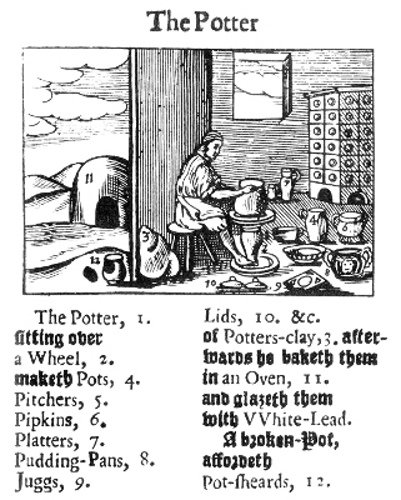 The Potter:
The Potter:The Potter 1, sitting over a Wheel 2, maketh Pots 4, Pitchers 5, Pipkins
6, Platters 7, Pudding-Pans 8, Juggs 9, Lids 10, &c of Potters-clay
3, afterwards he baketh them in an Oven 11, and glazeth them with
White-Lead. A broken pot, affordeth Pot-sheards, 12.
Courtesy Folger Shakespeare Library, Washington, D. C.
Making Pottery In The Seventeenth Century
The kick wheel used by the Jamestown potter may have resembled the one in the seventeenth-century engraving.
From Orbis Sensualium Pictus by Johann Comenius (London, 1685).
As early as 1608 two goldsmiths—William Johnson and Richard Belfield—emigrated to Jamestown. With them were two refiners and a jeweler. Although John Smith wrote that these artisans "never had occasion to exercise their craft," it is possible that they made a few small objects of silver, pewter, and latten metal (a brass-like alloy).
In spite of the fact that few specimens of silver and pewter were found at Jamestown, seventeenth century records and inventories indicate that many Virginia families owned such wares, including cups, beakers, dishes, salts, salvers, tankards, porringers, bowls, and plates.
A pewterer who lived thirty miles from Jamestown—Joseph Copeland by name—made the oldest dated piece of American pewter which has been found. In the 1930's, National Park Service archeologists, working at Jamestown, recovered the significant specimen—an incomplete pewter spoon which is a variant of the trifid or split-end type common during the 1650-1690 period. Impressed on the handle, in the trefoil finial of the stem is the mark of the maker, giving his name, the Virginia town where he worked, and the year he started business. The matchless spoon bears the sole surviving "touch" or mark of an American pewterer of the seventeenth century. The complete legend, encircling a heart, reads: "IOSEPH COPELAND/1675/CHUCKATUCK." (Chuckatuck is a small Virginia village located about thirty miles southeast of Jamestown.) Copeland later moved to Jamestown, and as he worked in the statehouse from 1688-1691 he may have made pewter in Virginia's capital "Citty."
The conjectural sketch shows a Jamestown metalworker making spoons.
 Making Pewter Spoons At Jamestown About 1675
Making Pewter Spoons At Jamestown About 1675
Conjectural sketch
 Photo courtesy National Park Service
Photo courtesy National Park Service
A Unique Pewter Spoon Handle Found At Jamestown
The rather commonplace and incomplete spoon fragment illustrated is significant for many reasons. Its prime importance is that it is the oldest known pewter object of American manufacture. The mark on the handle is the sole surviving one of an American pewterer of the seventeenth century. The mark reveals that the spoon was made in 1675 by Joseph Copeland, who worked at Chuckatuck, Virginia (located thirty miles southeast of Jamestown).
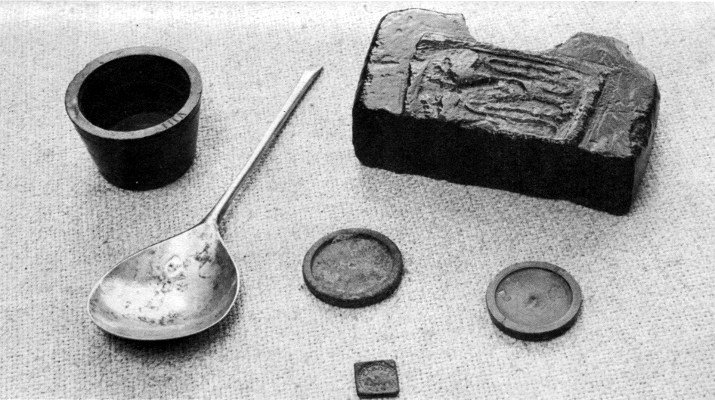 Photo courtesy National Park Service.
Photo courtesy National Park Service.
Items Left At Jamestown By Early Metalworkers
The brass weights, ingot of scrap brass, and silver spoon shown, which were unearthed at Jamestown, are reminders of a bygone day when metalworkers made beautiful things in Virginia's colonial capital over three centuries ago. Contemporary records indicate that many metalworkers emigrated to Virginia during the seventeenth century.
When the first settlers planted their small colony at Jamestown the tidewater rivers and bays teemed with many kinds of fish and seafood. Varieties which soon appeared on the colonists' tables included sheepshead, shad, sturgeon, herring, sole, white salmon, bass, flounder, pike, bream, perch, rock, and drum; as well as oysters, crabs, and mussels.
The day after the colonists reached Virginia, April 27 1607, George Percy observed that the oysters were large and tasty:
We came to a place where they [the Indians] had made a great fire, and had beene newly a rosting oysters. When they perceived our comming, they fled away to the mountaines, and left many of the oysters in the fire. We eat some of the oysters, which were very large and delicate in taste.
The following day, April 28, Percy noted that some of the oysters had pearls:
... we got good store of mussels and oysters, which lay on the ground as thicke as stones. Wee opened some, and found in many of them pearles.
The Jamestown planters who wrote accounts of the new colony commented on the abundance and variety of fish and shellfish in the rivers and creeks near the "capital citty." It seems rather surprising, therefore, that so many colonists died during the first autumn "of meere famine," as reported by Percy, when the James River teemed with fish, oysters, and crabs.
Captain Gabriel Archer, Gentleman, mentioned a seven foot sturgeon which was caught on June 13 1607: "Our Admiralls men gatt a sturgeon of 7 foote long which Captayne Newport gave us." George Percy commented on [Pg 57] the excellence of the sturgeon in the James River:
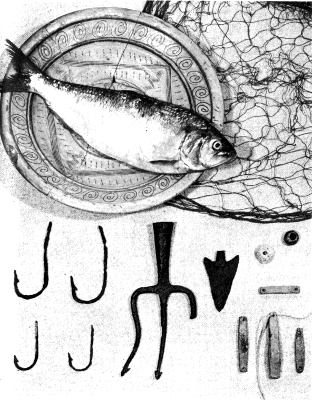 Photo courtesy National Park Service.
Photo courtesy National Park Service.
Fishhooks, Fish-gigs, Lead Net-Weights
The artifacts shown were excavated at Jamestown. These objects and many others found, are reminders of a day when fish and shellfish lived in abundance in every creek, river, and bay, in Tidewater Virginia.
There are many branches of this river, which runne flowing through the woods with great plentie of fish of all kindes; as for sturgeon, all the world cannot be compared to it....
John Smith and William Strachey also listed the delicious and palatable varieties of fish and shellfish which were found in Virginia waters, revealing that seafood was an important source of food for the colonists. At times, especially during the early years, it was one of the main sources.
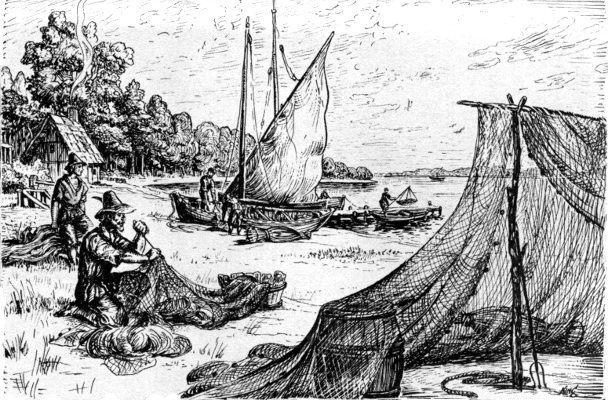 Repairing Nets At Jamestown About 1620
Repairing Nets At Jamestown About 1620Conjectural sketch
Seafood was an important food for the early colonists. At times, especially during the first years of the settlement, it was one of the main foodstuffs.
One seventeenth century building unearthed at Jamestown appears to have been used as a place where beer, ale, brandy, and other alcoholic beverages were made. Nearby were found pieces of lead, which may have been part of a lead cistern which held barley, and inside the building were three brick ovens, which may have been used for drying malt. A handle from a copper kettle was discovered near one of the ovens, and pieces of copper and lead pipes were recovered not far from the building. Historical objects excavated near the site revealed that the structure was used between 1625 and 1660.
A 1685 account relating to brewing could very well refer to a Jamestown establishment where beer and other beverages were made nearly 300 years ago:
Where wine is not to be had they drink beer, which is brewed of malt and hops, in a caldron. Afterwards it is powred into vatts, and when it is cold, it is carried in soes [wooden pails], into the cellar and is put into vessels.
Brandy-wine, extracted by the power of heat from dregs of wine in a pan, over which a limbeck [an apparatus used in distillation] is placed, droppeth thorow a pipe into a glass.
Wine and beer, when they turn sowr, become vinegar.
They make mede of wine and honey.
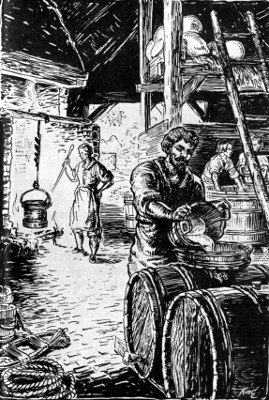 Brewing Beer
Brewing BeerConjectural sketch
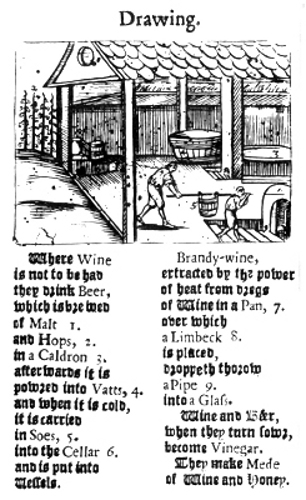 Drawing.
Drawing.Where Wine is not to be had they drink Beer, which is brewed of Malt 1, and Hops 2, in a Caldron 3, afterwards it is powred into Vatts 4, and when it is cold, it is carried in Soes 5, into the Cellar 6, and is put into Vessels. Brandy-wine, extracted by the power of heat from dregs of Wine in a Pan 7, over which a Limbeck 8, is placed droppeth thorow a Pipe 9, into a Glass. Wine and Beer, when they turn sowr, become Vinegar. They make Mede of Wine and Honey.
Courtesy Folger Shakespeare Library, Washington, D. C.
Beer, Brandy, Mead, and Vinegar
These beverages may have been made at Jamestown in a building somewhat similar to the one shown in the 1685 engraving.
From Orbis Sensualium Pictus by Johann Comenius (London, 1685).
 Photo courtesy National Park Service.
Photo courtesy National Park Service.Artifacts Unearthed Relating To Brewing And Distilling
Shown are lead and copper pipes, kettle fragments, a brass spigot, and scrap metal. It is believed that most of the beer and ale brewed at Jamestown after 1620 was made by the common brewer. One act, passed in 1620/21 "for the repressinge of the odious ... sinne of drunkenesse," stated that "noe person ... shall at any tyme ... brewe anie beere or ale, and sell the same againe in his or her house ... unless it bee in townes where there is noe comon brewer."
Among commodities which the early Jamestown settlers searched for were herbs and medicinal plants. It is possible that Thomas Wotton and Will Wilkinson, surgeons with the first colony, were the first members of the English medical profession to collect and experiment with New World plants.
The few colonists who wrote of their travels in Virginia frequently made mention of the herbs and native plants. George Percy related that five days after the settlers had planted their colony at Jamestown, May 19, 1607, that "One of the savages brought us on the way to the wood-side, where there was a garden of tobacco and other fruits and herbes."
On an exploring trip upriver from Jamestown in late May, 1607, Gabriel Archer recorded that "One [savage] shewed us the herbe called in their tongue wisacan, which they say heales poysoned woundes, it is like lyverwort or bloudwort."
John Smith mentioned the spring herbs, though he did not know their names: "Many hearbes in the spring time there are common dispersed throughout the woods, good for brothes and sallets, as violets, purslin, sorrell, &c. Besides many we used whose names we know not."
The first supply, approximately 120 settlers, reached Jamestown in midwinter and early spring, 1608. Among the group was a physician, Dr. Walter Russell; a surgeon, Post Ginnatt; and two apothecaries, Thomas Feld and John Harford. There is no record, however, indicating that these men used Virginia plants and herbs for medicinal purposes.
The man who first made intensive experiments with native plants was Doctor Lawrence Bohun. Arriving at Jamestown in 1610, he is mentioned several times by William Strachey, who [Pg 65] also reached Jamestown in 1610, in The Historie of Travell into Virginia Britania 1612:
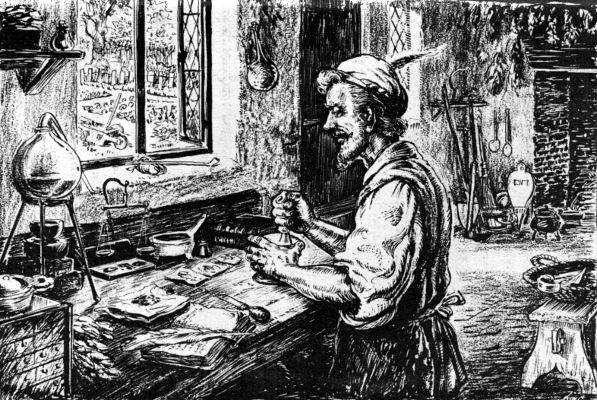 Doctor Lawrence Bohun Experimenting With Herbs At
Jamestown, 1610
Doctor Lawrence Bohun Experimenting With Herbs At
Jamestown, 1610Conjectural sketch
There groweth in the Island of James-towne a smale tree of leaves, armes and fruict, like the myrtle-tree, the fruict thereof hath a tast with the mirtle, but much more bynding, these trees grow in great plentye, rownd about a standing pond of fresh water in the middle of the Island; the pill or rynd whereof is of so great force against inveterate dissentericall fluxes of which Doctor Bohoune made open experiment in many of our men labouring with such diseases and therefore wisheth all such phisitians as shall goe thither to make use thereof.
As early as 1610 the Virginia Company of London instructed the colonists to send the following plants to England: sassafras, bayberries, "poccone to be gotten from the Indians," "galbrand [galbanum] groweth like fennell," sarsaparilla, and walnut oil. Other plants, both native and exotic, which were cultivated at Jamestown for medicinal purposes included mastic, woodbine, senna, snakeroot, dittany, mechoacan, pepper-wort, Jamestown (or Jimson) weed, wild cherry, and rhubarb.
Most of the herbs which were cultivated in English gardens grew successfully in Virginia, especially the ones listed in John Gerard's The Herbal (London, 1597), and William Lawson's The Country Housewifes Garden (London, 1617). Many contemporary records reveal that several herbs were used for medicinal purposes as well as for improving the flavor of certain foods and beverages.
A few herbs still grow on Jamestown Island, and together with the native sassafras, bayberry, wild bergamot, and bee balm, they remind us that the wilderness physicians, surgeons, and apothecaries did everything in their power to keep the English settlers alive and well three centuries ago.
 Photo courtesy National Park Service
Photo courtesy National Park Service
Items Used By Jamestown Doctors And Apothecaries
The drug jars, ointment pot, vials, and mortar and pestle fragments remind us that physicians, surgeons, and apothecaries experimented with herbs and native plants three centuries ago—attempting to keep the Jamestown colonists alive and well.
Virginia in the seventeenth century was a woodsman's paradise, and there is every reason to believe that most of the furniture used in Jamestown houses was made by colonial cabinetmakers. In the forests grew magnificent specimens of oak, walnut, pine, cypress, cedar, maple, and many other varieties; and although contemporary records are scanty, it is believed that the "James Citty" furniture makers made skillful use of such woods. William Strachey, who reached Jamestown in 1610, wrote that the church furniture was made of cedar and black walnut:
It [the church] is in length threescore foote, in breadth twenty foure, and shall have a chancell in it of cedar, and a communion table of blake walnut, and all the pewes of cedar, ... a pulpet of the same, with a font hewen hollow, like a canoa....
In spite of the fact that few records exist regarding the kinds of furniture made in the seventeenth century by Virginia cabinetmakers, the pieces extant reveal that the English styles were followed closely. While it is true that the wealthy planters imported some ornamented furniture from London, much of their furniture was made on the plantations. It is believed that practically all furniture used by the yeomen settlers was locally made.
 A Jamestown Cabinetmaker At Work
A Jamestown Cabinetmaker At Work
Conjectural sketch
 Photo courtesy National Park Service.
Photo courtesy National Park Service.Tools Unearthed At Jamestown Which Were Used by Coopers, Carpenters, And
Furniture Makers
Shown are gouges, augers, chisels, bits and hammers; an adze, hewing-axe, punch, race-knife, scriber, and wedge. All were hand wrought during the seventeenth century.[Pg 71]
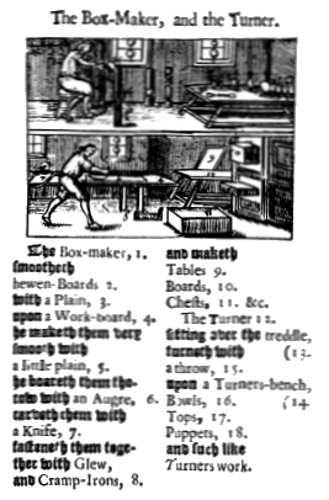 The Box-Maker, and the Turner.
The Box-Maker, and the Turner.The Box-Maker 1, smootheth hewen-Boards 2, with a Plain 3, upon a Work-board 4, he maketh them very smooth with a little plain 5, he boareth them thorow with an Augre 6, carveth them with a Knife 7, fasteneth them together with Glew, and Cramp-Irons 8, and maketh Tables 9, Boards 10, Chests 11, &c. The Turner 12, sitting over the treddle 13, turneth with a throw 14, upon a Turners-bench 15, Bowls 16, Tops 17, Puppets 18, and such like Turners work.
Courtesy Folger Shakespeare Library, Washington, D. C.
The Box Maker And Turner
Many tools similar to those in the 1685 engraving have been unearthed at Jamestown.
From Orbis Sensualium Pictus by Johann Comenius (London, 1685). [Pg 72]
 Carriages Vehicula:
Carriages Vehicula:We are carried on a Sled 1, over Snow, and Ice. A Carriage with one Wheel is called a Wheel-barrow; 2, with two Wheels a Cart; 3, with four Wheels a Wagon, which is either a Timber-wagon 4, or a Load-wagon 5. The parts of a Wagon, are, the Neep, (or draught-tree,) 6, the Beam 7, the Bottom 8, and the Sides 9, 10. Then the Axle-trees 10, about which the Wheels run the Lin-Pins 11, and Axletree-staves 12, being fastened before them. The Nave 13, is the ground-fast of the Wheel 14, from which com twelve Spokes; 15. The Ring encompasseth these, which is made of six Fellows 16, and as many Strakes 17, Hampiers, & Hurdles 18, are set in a Wagon.
Courtesy Folger Shakespeare Library, Washington, D. C.
Seventeenth Century Carriages
Wheeled vehicles used at Jamestown 300 years ago were probably similar in appearance to the ones shown in the 1685 engraving. A wheelbarrow, cart, timber wagon, load wagon, and sled are illustrated.
From Orbis Sensualium Pictus by Johann Comenius (London, 1685).
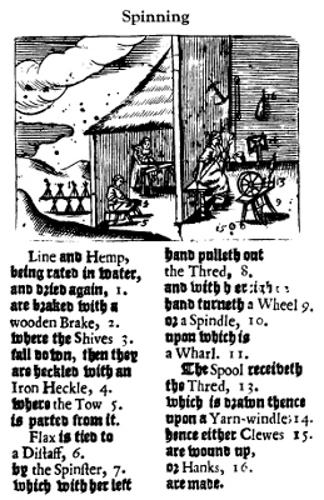 Spinning
SpinningLine and Hemp, being rated in water, and dried again 1, are braked with a wooden Brake 2, where the Shives 3, fall down, then they are heckled with an Iron Heckle 4, where the Tow 5, is parted from it. Flax is tied to a Distaff 6, by the Spinster 7, which with her left hand pulleth out the Thred 8, and with her righte hand turneth a Wheel 9, or a Spindle 10, upon which is a Wharl 11. The Spool receiveth the Thred 13, which is drawn thence upon a Yarn-windle; 14, hence either Clewes 15, are wound up, or Hanks 16, are made.
Courtesy Folger Shakespeare Library, Washington, D. C.
Making Linen Thread
The various steps depicted in the making of linen thread were used at Jamestown during the seventeenth century.
From Orbis Sensualium Pictus by Johann Comenius (London, 1685).
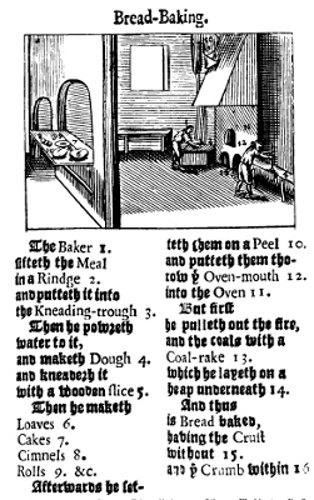 Bread-Baking.
Bread-Baking.The Baker 1, sifteth the Meal in a Rindge 2, and putteth it into the Kneading-trough 3. Then he powreth water to it, and maketh Dough 4, and kneadeth it with a wooden slice 5. Then he maketh Loaves 6, Cakes 7, Cimnels 8, Rolls 9. &c. Afterwards he setteth them on a Peel 10, and putteth them thorow ye Oven-mouth 12, into the Oven 11. But first he pulleth out the fire, and the coals with a Coal-rake 13, which he layeth on a heap underneath 14. And thus is Bread baked, having the Crust without 15, and ye Crumb within 16.
Courtesy Folger Shakespeare Library, Washington, D. C.
Baking Bread In 1685
The seventeenth century engraving shows how bread was baked almost 300 years ago.
From Orbis Sensualium Pictus by Johann Comenius (London, 1685).
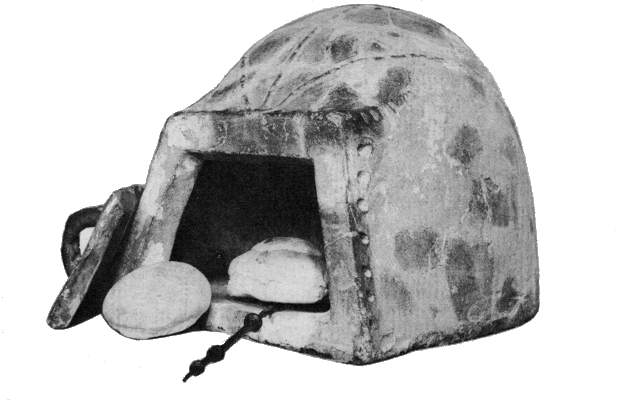
Photo courtesy National Park Service.
Baking Oven Used At Jamestown Three Centuries Ago
The earthenware baking oven shown was restored from over 200 fragments found during archeological excavations at Jamestown. In use, heated stones were placed inside and left until the walls of the oven were hot enough for baking. Sometimes the oven was placed directly on the embers. With the small thick door in place, heat was retained for considerable time—the domed top reflecting the heat down on the bread or cakes that were being baked.

Research on painting by author. Photo courtesy National Park Service.
"Harvesting" Ice At Jamestown About 1640
Conjectural Painting
Although not a commodity in the strict sense of the word, an icehouse was indispensable in preserving certain products. Archeological explorations at Jamestown revealed that icehouses were built on the island over 300 years ago. Ice was "harvested" during the winter months, and often remained in storage as late as September or October. It was used for cooling bottled wines, "firming" butter, and keeping fresh certain foods, such as fish, meats, and dairy products. In the illustration men are carrying ice to the circular-shaped, brick, icehouse. In the distance a man is sawing ice.

Research on painting by author. Photo courtesy National Park Service.
A Happy Home In Jamestown
Conjectural Painting
The early Jamestown settlers were self-sufficient to a large degree when they arrived in the New World, and so they remained. Cut off from communication with the mother country for long periods of time, they had to rely upon their own resources. If they needed a thing they usually had to make it with their own hands or do without. These homemade objects—including cloth, pottery, tools, woodenware, furniture, brick and tiles, and many household accessories—were well-made and extremely practical. Many items made in the home were not entirely lacking in beauty.[Pg 78]
Bailey, Worth. "Joseph Copeland, Seventeenth Century Pewterer."
Antiques, April, 1938. 188-190.
----"Lime preparation at Jamestown in the Seventeenth Century."
William and Mary College Quarterly Historical Magazine, 2nd
series. January, 1938. 1-12.
Bruce, Philip Alexander. Economic History of Virginia in the
Seventeenth Century. New York, 1935. 2 vols.
Forman, Henry Chandlee. Jamestown and St. Mary's: Buried Cities of
Romance. Baltimore, 1938.
Harrington, J. C. Glassmaking at Jamestown. Richmond, 1952. 48 p.
----"Seventeenth-Century Brickmaking and Tilemaking at Jamestown,
Virginia." The Virginia Magazine of History and Biography,
January, 1950. 16-39.
----"Some Delft Tiles Found at Jamestown." Antiques, January,
1951. 36, 37.
Hudson, J. Paul. "The Story of Iron at Jamestown, Virginia, where
Iron Objects Were Wrought by Englishmen Almost 350 Years Ago." The
Iron Worker, Summer, 1956. 2-14.
----and C. Malcolm Watkins. "The Earliest Known English Colonial
Pottery in America." Antiques, January, 1957. 51-54.
Innocent, C. F. The Development of English Building Construction.
Cambridge, England, 1916. 294 p.
Peterson, Harold L. Arms and Armor in Colonial America, 1526-1783.
Harrisburg, Pa., 1956. 350 p.
Salzman, L. F. English Industries of the Middle Ages. Oxford,
England, 1923. 360 p.
Transcriber's Note: The spelling and punctuation of the original publication has been retained. Obvious extracts of quotations have been marked with quotation marks.
***END OF THE PROJECT GUTENBERG EBOOK A PICTORIAL BOOKLET ON EARLY JAMESTOWN COMMODITIES AND INDUSTRIES***
******* This file should be named 40080-h.txt or 40080-h.zip *******
This and all associated files of various formats will be found in:
http://www.gutenberg.org/4/0/0/8/40080
Updated editions will replace the previous one--the old editions will be renamed.
Creating the works from public domain print editions means that no one owns a United States copyright in these works, so the Foundation (and you!) can copy and distribute it in the United States without permission and without paying copyright royalties. Special rules, set forth in the General Terms of Use part of this license, apply to copying and distributing Project Gutenberg-tm electronic works to protect the PROJECT GUTENBERG-tm concept and trademark. Project Gutenberg is a registered trademark, and may not be used if you charge for the eBooks, unless you receive specific permission. If you do not charge anything for copies of this eBook, complying with the rules is very easy. You may use this eBook for nearly any purpose such as creation of derivative works, reports, performances and research. They may be modified and printed and given away--you may do practically ANYTHING with public domain eBooks. Redistribution is subject to the trademark license, especially commercial redistribution.
To protect the Project Gutenberg-tm mission of promoting the free distribution of electronic works, by using or distributing this work (or any other work associated in any way with the phrase "Project Gutenberg"), you agree to comply with all the terms of the Full Project Gutenberg-tm License available with this file or online at www.gutenberg.org/license.
1.A. By reading or using any part of this Project Gutenberg-tm electronic work, you indicate that you have read, understand, agree to and accept all the terms of this license and intellectual property (trademark/copyright) agreement. If you do not agree to abide by all the terms of this agreement, you must cease using and return or destroy all copies of Project Gutenberg-tm electronic works in your possession. If you paid a fee for obtaining a copy of or access to a Project Gutenberg-tm electronic work and you do not agree to be bound by the terms of this agreement, you may obtain a refund from the person or entity to whom you paid the fee as set forth in paragraph 1.E.8.
1.B. "Project Gutenberg" is a registered trademark. It may only be used on or associated in any way with an electronic work by people who agree to be bound by the terms of this agreement. There are a few things that you can do with most Project Gutenberg-tm electronic works even without complying with the full terms of this agreement. See paragraph 1.C below. There are a lot of things you can do with Project Gutenberg-tm electronic works if you follow the terms of this agreement and help preserve free future access to Project Gutenberg-tm electronic works. See paragraph 1.E below.
1.C. The Project Gutenberg Literary Archive Foundation ("the Foundation" or PGLAF), owns a compilation copyright in the collection of Project Gutenberg-tm electronic works. Nearly all the individual works in the collection are in the public domain in the United States. If an individual work is in the public domain in the United States and you are located in the United States, we do not claim a right to prevent you from copying, distributing, performing, displaying or creating derivative works based on the work as long as all references to Project Gutenberg are removed. Of course, we hope that you will support the Project Gutenberg-tm mission of promoting free access to electronic works by freely sharing Project Gutenberg-tm works in compliance with the terms of this agreement for keeping the Project Gutenberg-tm name associated with the work. You can easily comply with the terms of this agreement by keeping this work in the same format with its attached full Project Gutenberg-tm License when you share it without charge with others.
1.D. The copyright laws of the place where you are located also govern what you can do with this work. Copyright laws in most countries are in a constant state of change. If you are outside the United States, check the laws of your country in addition to the terms of this agreement before downloading, copying, displaying, performing, distributing or creating derivative works based on this work or any other Project Gutenberg-tm work. The Foundation makes no representations concerning the copyright status of any work in any country outside the United States.
1.E. Unless you have removed all references to Project Gutenberg:
1.E.1. The following sentence, with active links to, or other immediate access to, the full Project Gutenberg-tm License must appear prominently whenever any copy of a Project Gutenberg-tm work (any work on which the phrase "Project Gutenberg" appears, or with which the phrase "Project Gutenberg" is associated) is accessed, displayed, performed, viewed, copied or distributed:
This eBook is for the use of anyone anywhere at no cost and with almost no restrictions whatsoever. You may copy it, give it away or re-use it under the terms of the Project Gutenberg License included with this eBook or online at www.gutenberg.org
1.E.2. If an individual Project Gutenberg-tm electronic work is derived from the public domain (does not contain a notice indicating that it is posted with permission of the copyright holder), the work can be copied and distributed to anyone in the United States without paying any fees or charges. If you are redistributing or providing access to a work with the phrase "Project Gutenberg" associated with or appearing on the work, you must comply either with the requirements of paragraphs 1.E.1 through 1.E.7 or obtain permission for the use of the work and the Project Gutenberg-tm trademark as set forth in paragraphs 1.E.8 or 1.E.9.
1.E.3. If an individual Project Gutenberg-tm electronic work is posted with the permission of the copyright holder, your use and distribution must comply with both paragraphs 1.E.1 through 1.E.7 and any additional terms imposed by the copyright holder. Additional terms will be linked to the Project Gutenberg-tm License for all works posted with the permission of the copyright holder found at the beginning of this work.
1.E.4. Do not unlink or detach or remove the full Project Gutenberg-tm License terms from this work, or any files containing a part of this work or any other work associated with Project Gutenberg-tm.
1.E.5. Do not copy, display, perform, distribute or redistribute this electronic work, or any part of this electronic work, without prominently displaying the sentence set forth in paragraph 1.E.1 with active links or immediate access to the full terms of the Project Gutenberg-tm License.
1.E.6. You may convert to and distribute this work in any binary, compressed, marked up, nonproprietary or proprietary form, including any word processing or hypertext form. However, if you provide access to or distribute copies of a Project Gutenberg-tm work in a format other than "Plain Vanilla ASCII" or other format used in the official version posted on the official Project Gutenberg-tm web site (www.gutenberg.org), you must, at no additional cost, fee or expense to the user, provide a copy, a means of exporting a copy, or a means of obtaining a copy upon request, of the work in its original "Plain Vanilla ASCII" or other form. Any alternate format must include the full Project Gutenberg-tm License as specified in paragraph 1.E.1.
1.E.7. Do not charge a fee for access to, viewing, displaying, performing, copying or distributing any Project Gutenberg-tm works unless you comply with paragraph 1.E.8 or 1.E.9.
1.E.8. You may charge a reasonable fee for copies of or providing access to or distributing Project Gutenberg-tm electronic works provided that
1.E.9. If you wish to charge a fee or distribute a Project Gutenberg-tm electronic work or group of works on different terms than are set forth in this agreement, you must obtain permission in writing from both the Project Gutenberg Literary Archive Foundation and Michael Hart, the owner of the Project Gutenberg-tm trademark. Contact the Foundation as set forth in Section 3 below.
1.F.
1.F.1. Project Gutenberg volunteers and employees expend considerable effort to identify, do copyright research on, transcribe and proofread public domain works in creating the Project Gutenberg-tm collection. Despite these efforts, Project Gutenberg-tm electronic works, and the medium on which they may be stored, may contain "Defects," such as, but not limited to, incomplete, inaccurate or corrupt data, transcription errors, a copyright or other intellectual property infringement, a defective or damaged disk or other medium, a computer virus, or computer codes that damage or cannot be read by your equipment.
1.F.2. LIMITED WARRANTY, DISCLAIMER OF DAMAGES - Except for the "Right of Replacement or Refund" described in paragraph 1.F.3, the Project Gutenberg Literary Archive Foundation, the owner of the Project Gutenberg-tm trademark, and any other party distributing a Project Gutenberg-tm electronic work under this agreement, disclaim all liability to you for damages, costs and expenses, including legal fees. YOU AGREE THAT YOU HAVE NO REMEDIES FOR NEGLIGENCE, STRICT LIABILITY, BREACH OF WARRANTY OR BREACH OF CONTRACT EXCEPT THOSE PROVIDED IN PARAGRAPH 1.F.3. YOU AGREE THAT THE FOUNDATION, THE TRADEMARK OWNER, AND ANY DISTRIBUTOR UNDER THIS AGREEMENT WILL NOT BE LIABLE TO YOU FOR ACTUAL, DIRECT, INDIRECT, CONSEQUENTIAL, PUNITIVE OR INCIDENTAL DAMAGES EVEN IF YOU GIVE NOTICE OF THE POSSIBILITY OF SUCH DAMAGE.
1.F.3. LIMITED RIGHT OF REPLACEMENT OR REFUND - If you discover a defect in this electronic work within 90 days of receiving it, you can receive a refund of the money (if any) you paid for it by sending a written explanation to the person you received the work from. If you received the work on a physical medium, you must return the medium with your written explanation. The person or entity that provided you with the defective work may elect to provide a replacement copy in lieu of a refund. If you received the work electronically, the person or entity providing it to you may choose to give you a second opportunity to receive the work electronically in lieu of a refund. If the second copy is also defective, you may demand a refund in writing without further opportunities to fix the problem.
1.F.4. Except for the limited right of replacement or refund set forth in paragraph 1.F.3, this work is provided to you 'AS-IS', WITH NO OTHER WARRANTIES OF ANY KIND, EXPRESS OR IMPLIED, INCLUDING BUT NOT LIMITED TO WARRANTIES OF MERCHANTABILITY OR FITNESS FOR ANY PURPOSE.
1.F.5. Some states do not allow disclaimers of certain implied warranties or the exclusion or limitation of certain types of damages. If any disclaimer or limitation set forth in this agreement violates the law of the state applicable to this agreement, the agreement shall be interpreted to make the maximum disclaimer or limitation permitted by the applicable state law. The invalidity or unenforceability of any provision of this agreement shall not void the remaining provisions.
1.F.6. INDEMNITY - You agree to indemnify and hold the Foundation, the trademark owner, any agent or employee of the Foundation, anyone providing copies of Project Gutenberg-tm electronic works in accordance with this agreement, and any volunteers associated with the production, promotion and distribution of Project Gutenberg-tm electronic works, harmless from all liability, costs and expenses, including legal fees, that arise directly or indirectly from any of the following which you do or cause to occur: (a) distribution of this or any Project Gutenberg-tm work, (b) alteration, modification, or additions or deletions to any Project Gutenberg-tm work, and (c) any Defect you cause.
Project Gutenberg-tm is synonymous with the free distribution of electronic works in formats readable by the widest variety of computers including obsolete, old, middle-aged and new computers. It exists because of the efforts of hundreds of volunteers and donations from people in all walks of life.
Volunteers and financial support to provide volunteers with the assistance they need are critical to reaching Project Gutenberg-tm's goals and ensuring that the Project Gutenberg-tm collection will remain freely available for generations to come. In 2001, the Project Gutenberg Literary Archive Foundation was created to provide a secure and permanent future for Project Gutenberg-tm and future generations. To learn more about the Project Gutenberg Literary Archive Foundation and how your efforts and donations can help, see Sections 3 and 4 and the Foundation information page at www.gutenberg.org
The Project Gutenberg Literary Archive Foundation is a non profit 501(c)(3) educational corporation organized under the laws of the state of Mississippi and granted tax exempt status by the Internal Revenue Service. The Foundation's EIN or federal tax identification number is 64-6221541. Contributions to the Project Gutenberg Literary Archive Foundation are tax deductible to the full extent permitted by U.S. federal laws and your state's laws.
The Foundation's principal office is located at 4557 Melan Dr. S. Fairbanks, AK, 99712., but its volunteers and employees are scattered throughout numerous locations. Its business office is located at 809 North 1500 West, Salt Lake City, UT 84116, (801) 596-1887. Email contact links and up to date contact information can be found at the Foundation's web site and official page at www.gutenberg.org/contact
For additional contact information:
Dr. Gregory B. Newby
Chief Executive and Director
gbnewby@pglaf.org
Project Gutenberg-tm depends upon and cannot survive without wide spread public support and donations to carry out its mission of increasing the number of public domain and licensed works that can be freely distributed in machine readable form accessible by the widest array of equipment including outdated equipment. Many small donations ($1 to $5,000) are particularly important to maintaining tax exempt status with the IRS.
The Foundation is committed to complying with the laws regulating charities and charitable donations in all 50 states of the United States. Compliance requirements are not uniform and it takes a considerable effort, much paperwork and many fees to meet and keep up with these requirements. We do not solicit donations in locations where we have not received written confirmation of compliance. To SEND DONATIONS or determine the status of compliance for any particular state visit www.gutenberg.org/donate
While we cannot and do not solicit contributions from states where we have not met the solicitation requirements, we know of no prohibition against accepting unsolicited donations from donors in such states who approach us with offers to donate.
International donations are gratefully accepted, but we cannot make any statements concerning tax treatment of donations received from outside the United States. U.S. laws alone swamp our small staff.
Please check the Project Gutenberg Web pages for current donation methods and addresses. Donations are accepted in a number of other ways including checks, online payments and credit card donations. To donate, please visit: www.gutenberg.org/donate
Professor Michael S. Hart was the originator of the Project Gutenberg-tm concept of a library of electronic works that could be freely shared with anyone. For forty years, he produced and distributed Project Gutenberg-tm eBooks with only a loose network of volunteer support.
Project Gutenberg-tm eBooks are often created from several printed editions, all of which are confirmed as Public Domain in the U.S. unless a copyright notice is included. Thus, we do not necessarily keep eBooks in compliance with any particular paper edition.
Most people start at our Web site which has the main PG search facility: www.gutenberg.org
This Web site includes information about Project Gutenberg-tm, including how to make donations to the Project Gutenberg Literary Archive Foundation, how to help produce our new eBooks, and how to subscribe to our email newsletter to hear about new eBooks.